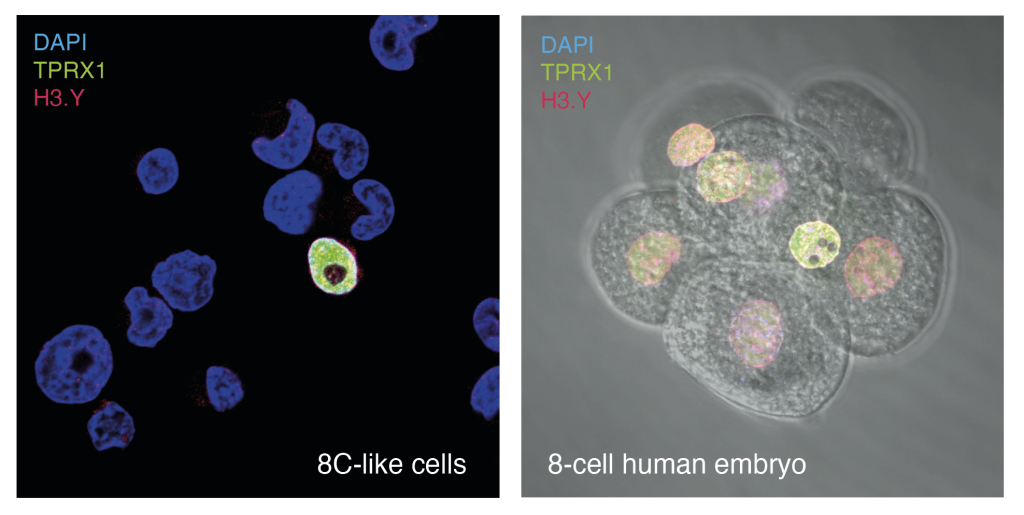The first lineage decisions in mammalian embryonic development are made shortly after a wave of transcriptional activation that acts as a wake-up call for the sleeping embryonic genome to claim the reigns of cellular activity from the maternal genome. This occurs in mice at the 2-cell stage and in humans at the 8-cell stage.
Until now, investigations into human zygotic genome activation (ZGA) could only be carried out in human embryos since human stem cell models were only representative of later stages of development. Due to regulatory restrictions, this necessitated the use of non-human models to study ZGA and other landmarks in early human development.
In a new study, scientists at the Babraham Institute in U.K., have discovered a unique human cell state in culture that they call 8-cell-like cells (8CLCs), which transcriptionally resemble the 8-cell human embryo and can therefore be used as a model system to study ZGA and better understand errors at this pivotal stage that result in developmental disorders or embryonic death.
These findings were published on February 24, 2022, in an article in the journal Cell Stem Cell titled “8C-like cells capture the human zygotic genome activation program in vitro.” As 8CLCs express genes, integrated viruses, and proteins like 8-cell human embryos, they can be used to systematically study mechanisms of human embryonic genome activation in an accessible and noninvasive stem cell culture model.
“We have discovered a unique cell state that enables the molecular characterization of ZGA-like transcription in vitro. The appearance, maintenance, and enrichment of 8CLCs will allow the study of genome activation in culture and make it amenable to genetic and pharmacological manipulation in a high-throughput way,” the authors note.

Naïve pluripotent or embryonic stem cells (PSCs or ESCs) correspond to cells of the embryonic epiblast before the embryo implants into the uterine endometrium. A 2012 study had identified a small subpopulation of cultured cells among cells derived from naïve mouse ESCs that closely resembled 2-cell stage mouse embryos (2C-like cells, 2CLC). Although these cells have passed through ZGA in the embryonic context, in culture these cells periodically reactivate a ZGA-like transcriptional and epigenetic program.
Now, almost a decade later, researchers have discovered an in vitro human equivalent to the mouse 2CLCs. This work was done in the lab of Wolf Reik, PhD, group leader at the Babraham Institute, honorary professor of epigenetics at the University of Cambridge and associate faculty at the Wellcome Trust Sanger Institute.

Jasmin Taubenschmid-Stowers, PhD, a postdoctoral researcher in the Reik lab and the lead author of the study said, “Although so vital to our own lives, we know very little about the earliest events in human development. While we have stem cell model systems to functionally study ZGA on the molecular level in mouse, we lack the tools to study this in a human context. Mice, humans and other mammals share basic principles but are very different in the end. It is not enough to look for our answers in the mouse system.”
In the current study, the researchers used existing human and mouse ESC datasets to identify characteristic transcriptomic markers that could be linked to human ZGA. Using single cell techniques, they identified and validated the presence of cells in human ESC cultures that resembled the transcriptomic profile of cells in the human 8-cell stage embryo and called these ‘8-cell like cells’ or 8CLCs.
“We would not have been able to find these specific 8CLCs without novel single-cell RNA sequencing technologies,” said Taubenschmid-Stowers. “These methods allowed us to have a very detailed look at individual stem cells and compare them with human embryos in a high-throughput way. We found our 8CLCs not just in our newly generated dataset where we looked for them specifically, but also in data that has been published years ago. They have possibly always been there, however so far nobody has looked carefully enough to find them.”
Reik’s team worked with Jennifer Nichols, PhD, a professor at the Wellcome-MRC Cambridge Stem Cell Institute to demonstrate proteins present in 8CLCs closely match ZGA-associated proteins in 8-cell human embryos.
Taubenschmid-Stowers said, “The collaboration with Professor Nichols and her team was vital as we could identify selected proteins and really look at those in real, fixed human 8-cell stage embryo cells compared to our new stem cell counterparts. This work confirmed that our 8C-like cells matched at the protein level too, in addition to the transcriptome level, providing validation that the 8-cell like cells matched embryonic cells across multiple molecular layers.”
Studies conducted in this new system will still require validation through studies on human embryos, and although highly similar to 8-cell stage human embryos, 8CLCs have significant differences in molecular programs as well, posing limitations to the application of the new in vitro model.
In future studies the team plans to further characterize 8CLCs to identify molecular cues required for genome activation in human embryos. “Our focus is now to characterize these cells and understand their unique properties so that we can use 8-cell like cells as a tool to ask questions about the molecular changes that may cause developmental issues at this early stage.” said Reik.
“Discoveries made from studying ZGA-like transcription in vitro may also provide important insights into the regulation of genome activation during human pre-implantation development and may have vital consequences for reproduction, health, and technology,” the authors concluded.
The post Human Embryo at 8-Cell Stage Modeled in New Stem Cell Culture appeared first on GEN – Genetic Engineering and Biotechnology News.












